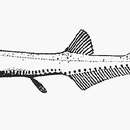Diagnostic Description
provided by Fishbase
Dark dorsum, flanks silver (Ref. 3988). Slender body, longer anal fin and tail set (Ref. 37473).
- Recorder
- Cristina V. Garilao
Migration
provided by Fishbase
Oceanodromous. Migrating within oceans typically between spawning and different feeding areas, as tunas do. Migrations should be cyclical and predictable and cover more than 100 km.
Morphology
provided by Fishbase
Dorsal spines (total): 0; Dorsal soft rays (total): 10 - 12; Analspines: 0; Analsoft rays: 22 - 30
- Recorder
- Cristina V. Garilao
Trophic Strategy
provided by Fishbase
An oceanic and mesopelagic species, adults and juveniles usually found at 200-500 m by day and the majority of them migrate into upper 100-200 m at night. Feeds mainly on small crustaceans.
- Recorder
- Drina Sta. Iglesia
Biology
provided by Fishbase
An oceanic and mesopelagic species, adults and juveniles usually found at 200-500 m by day and the majority of them migrate into upper 100-200 m at night. Feeds mainly on small crustaceans. Dioecious with peak spawning during summer. Adult photophore complement attained at about 25-27 mm SL (Ref. 4778).

